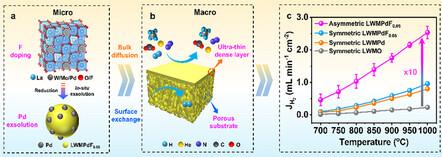具有优异氢分离性能的混合质子-电子导电膜的多维工程
IF 19
1区 材料科学
Q1 CHEMISTRY, MULTIDISCIPLINARY
引用次数: 0
摘要
混合质子-电子导电(MPEC)膜的高氢气渗透性和良好的化学稳定性(特别是在含二氧化碳的大气中)是实现实际氢气分离工艺的关键要求。本文提出了一种多维工程策略,从微观和宏观两方面开发高效的氟(F)掺杂不对称钨酸镧型La5.5(W0.6Mo0.4)0.95Pd0.05O11.25-δF0.05 (LWMPdF0.05)膜。在微观层面上,引入F的最强电负性阴离子和Pd纳米颗粒的原位溶出策略分别增强了膜的体积扩散和表面交换动力学。在宏观层面上,通过自旋涂层构建非对称结构,由多孔基板上支撑的薄致密层(≈8 μ m)组成。薄致密层显著降低了体扩散阻力,而具有大比表面积的多孔基板有效促进了表面交换过程。结果表明,这种不对称LWMPdF0.05膜在1000°C下具有2.5±0.2 mL min - 1 cm - 2的H2通量,在850°C下连续运行520 h时具有优异的化学稳定性,在实际氢气分离应用中具有很大的潜力。本文章由计算机程序翻译,如有差异,请以英文原文为准。

Multidimensional Engineering of Mixed Protonic-Electronic Conducting Membranes with Excellent Hydrogen Separation Performance
Both high H2 permeability and good chemical stability (particularly in CO2-containing atmospheres) of mixed protonic-electronic conducting (MPEC) membranes are the critical requirements toward practical H2 separation processes. Herein, a multidimensional engineering strategy is proposed to develop an efficient fluorine (F)-doped asymmetric lanthanum tungstate-type La5.5(W0.6Mo0.4)0.95Pd0.05O11.25-δF0.05 (LWMPdF0.05) membrane from both micro and macro levels. At the micro level, the introduction of the strongest electronegative anion of F and in-situ exsolution of Pd nanoparticles strategies are employed to enhance the membrane bulk diffusion and surface exchange kinetics, respectively. At the macro level, an asymmetric configuration is constructed via spin coating, consisting of a thin dense layer (≈8 µm) supported on a porous substrate. The thin dense layer significantly reduces bulk diffusion resistance, while the porous substrate with a large specific surface area effectively promotes surface exchange processes. As a result, this developed asymmetric LWMPdF0.05 membrane exhibits an unprecedented H2 flux of 2.5 ± 0.2 mL min−1 cm−2 at 1000 °C and excellent chemical stability during 520 h of continuous operation at 850 °C, demonstrating great potential for practical H2 separation applications.
求助全文
通过发布文献求助,成功后即可免费获取论文全文。
去求助
来源期刊

Advanced Functional Materials
工程技术-材料科学:综合
CiteScore
29.50
自引率
4.20%
发文量
2086
审稿时长
2.1 months
期刊介绍:
Firmly established as a top-tier materials science journal, Advanced Functional Materials reports breakthrough research in all aspects of materials science, including nanotechnology, chemistry, physics, and biology every week.
Advanced Functional Materials is known for its rapid and fair peer review, quality content, and high impact, making it the first choice of the international materials science community.
 求助内容:
求助内容: 应助结果提醒方式:
应助结果提醒方式:


